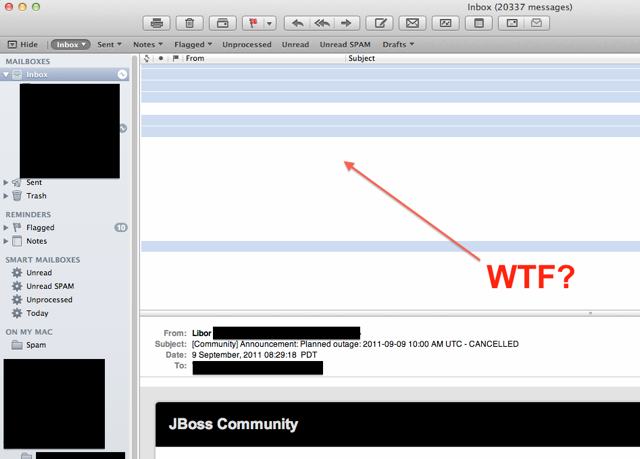Rebuilding Failed RAID1 on Mac OS X
I recently had one drive in a two non boot disk Mac OS X software RAID1 set being marked as FAILED. Since the disk seemed good, I shut down the computer, reseated all the drives and booted it back up. The failed drive showed up, but marked as FAILED.
I went to Terminal, and entered:
waldo@waldopcm-3 ~ $ sudo diskutil appleRAID list
AppleRAID sets (1 found)
===============================================================================
Name: Photo Library 2TB
Unique ID: 89A5283E-228D-46DE-B40C-9564642F0D21
Type: Mirror
Status: Degraded
Size: 2.0 TB (2000054910976 Bytes)
Rebuild: manual
Device Node: disk6
-------------------------------------------------------------------------------
# DevNode UUID Status Size
-------------------------------------------------------------------------------
0 disk0s2 1DAD80E6-852C-482C-8538-B517E0365597 Failed 2000054910976
1 disk3s2 38381E2E-D571-4EE6-9C58-D55502953D86 Online 2000054910976
===============================================================================VSS errors on Windows SBS 2003 R2
I recently tried setting up a TrueCrypt encrypted USB drive and a script that calls ntbackup to perform a full VSS based backup of the local server to that encrypted drive. However ntbackup kept on saying "Retrying VSS snapshot". Looking at the EventLog I saw these:
Event Type: Error
Event Source: VSS
Event Category: None
Event ID: 12293
Date: 9/13/2011
Time: 9:22:03 AM
User: N/A
Computer: SERVER
Description:Volume Shadow Copy Service error: Error calling a routine on the Shadow Copy Provider {b5946137-7b9f-4925-af80-51abd60b20d5}. Routine details IVssSnapshotProvider::QueryVolumesSupportedForSnapshots(ProviderId,29,...) [hr = 0x8000ffff].
Event Type: Warning
Event Source: VSS
Event Category: None
Event ID: 12290
Date: 9/13/2011
Time: 9:22:03 AM
User: N/A
Computer: SERVER
Description:Volume Shadow Copy Service warning: GetVolumeInformationW(\?Volume{f59cbf71-d9a1-1110-a86c-000423dec22f},NULL,0,NULL,NULL,[0x00000000], , 260) == 0x00000057. hr = 0x00000000.
Event Type: Error
Event Source: VolSnap
Event Category: None
Event ID: 22
Date: 9/13/2011
Time: 9:09:23 AM
User: N/A
Computer: SERVER
Description:The shadow copy storage volume specified for shadow copies on volume C: could not be added.
I ran
Real Life Troubleshooting
About 4 days ago I started hearing the dreaded click of death on my one Windows computer. Problem is, I have two RAID arrays - one RAID1 with two drives and one RAID5 with four drives. Then also a standalone OS drive.
So I installed SMART monitoring software - which told me my OS drive is OK. I was about to reboot to check the Adaptec RAID BIOS for the other disks when I decided to try and find the problematic HDD by ear. I have a fan blowing on my machine as the heat levels are just insane. So I stopped the fan to listen carefully, but the noise went away. Took me 5 minutes to confirm that with the fan on, the click of death is present and with it off the click of death was absent.
Weird… This is an external fan. How can it influence a failing hard drive?
Mail.app in Lion is BUGGY

Optimising PostgreSQL application Part II
Review Part I here. The best I could muster was 21 minutes in a co-located setup. To make the comparison fair, I am going to express it as a percentage of the pre-optimisation application / PostgreSQL DB on production versus my development machine.
| Production App | Production DB | Development Co-located | |
|---|---|---|---|
| CPU | 2 x Xeon 5140 2.33GHz (#4) | 1 x Xeon 5140 2.33GHz (#2) | Core i7 2600 3.4GHz (#4) |
| RAM | 4GiB | 4GiB | 12GiB |
| HDD | Enterprise SAN | Enterprise SAN | OCZ Vertex 3 240GB SSD |
| NIC | Broadcom Gigabit BCM5708S | Broadcom Gigabit BCM5708S | Intel Gigabit 82579V |
| PostgreSQL | - | fsync = off | fsync = on, synchronous_commit = off |
| Application | Unoptimised, single threaded | - | Optimised, multithreaded |
The performance increase between the Production App + Production DB server combo vs. my co-located development machine?